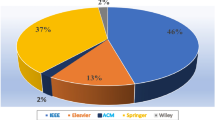Abstract
This paper presents a quality of service-aware resource scheduling algorithm targeted for downlink traffic in the UMTS Long-Term Evolution Medium Access Control layer with emphasis for support in an overload state. Specifically, multiple real-time traffic metrics including latency, loss, and queue depth are normalized and processed via an array of ranking functions and multiplexed into an aggregate rank. This aggregate rank is then used in a fractional knapsack scheduling implementation. Experiments with this scheduling mechanism show improved traffic processing intelligence over existing scheduling models, especially in overload states.


















Similar content being viewed by others
References
Cisco. (2012). Cisco Visual Networking Index: Global Mobile Data Traffic Forecast Update, 2011–2016. http://www.cisco.com/en/US/solutions/collateral/ns341/ns525/ns537/ns705/ns827/white_paper_c11-520862.pdf.
Leland, W. E., Willinger, W., Taqqu, M. S., & Wilson, D. V. (1995). On the self-similar nature of Ethernet traffic. ACM SIGCOMM Computer Communication Review, 25, 202–213.
Kela, P., Puttonen, J., Kolehmainen, N., Ristaniemi, T., Henttonen, T., & Moisio, M. (2008). Dynamic packet scheduling performance in UTRA Long Term Evolution downlink. In Wireless Pervasive Computing, 3rd International Symposium (pp. 308–313).
Kwan, R., Leung, C., & Zhang, J. (2009). Proportional fair multiuser scheduling in LTE. Signal Processing Letters, IEEE, 16, 461–464.
Mongha, G., Pedersen, K. I., Kovacs, I. Z., & Mogensen, P. E. (2008). QoS oriented time and frequency domain packet schedulers for the UTRAN Long Term Evolution. In Vehicular technology conference, spring 2008 (pp. 2532–2536). IEEE.
3GPP. (2011). Transparent end-to-end Packet-switched Streaming Service (PSS); Progressive Download and Dynamic Adaptive Streaming over HTTP (3GP-DASH), TS 26.247 v10.1.0.
Piro, G., Grieco, L. A., Boggia, G., Fortuna, R., & Camarda, P. (2011). Two-level downlink scheduling for real-time multimedia services in LTE networks. IEEE Transactions on Multimedia, 13, 1052–1065.
Zaki, Y., Weerawardane, T., Gorg, C., & Timm-Giel, A. (2011). Multi-QoS-aware fair scheduling for LTE. In Vehicular technology conference (VTC spring), 2011 IEEE 73rd (pp. 1–5).
3GPP. (2010). General Packet Radio Service (GPRS) enhancements for Evolved Universal Terrestrial Radio Access Network (E-UTRAN) access, TS 23.401 v9.4.0.
Hopfield, J. J. (1984). Neurons with graded response have collective computational properties like those of two-state neurons. Proceedings of the National academy of Sciences of the United States of America, 81, 3088–3092.
Mitchell, T. M. (1997). Machine learning. New York: WCB/McGraw-Hill.
Kellerer, H., Pferschy, U., & Pisinger, D. (2004). Knapsack problems. Berlin: Springer.
3GPP. (2007). R1-070674: LTE physical layer framework for performance verification.
Sesia, S., Toufik, I., & Baker, M. (Eds.). (2009). LTE: The UMTS Long Term Evolution, from theory to practice. Chichester, West Sussex, UK: Wiley.
Willinger, W., Taqqu, M. S., Sherman, R., & Wilson, D. V. (1997). Self-similarity through high-variability: Statistical analysis of Ethernet LAN traffic at the source level. IEEE/ACM Transactions on Networking, 5, 71–86.
Willinger, W., Paxson, V., & Taqqu, M. S. (1996). Self-similarity and heavy tails: Structural modeling of network traffic. doi:10.1.1.30.6033.
Crovella, M. E., & Bestavros, A. (1996). Self-similarity in world wide web traffic: Evidence and possible causes. doi:10.1.1.121.9337.
Kulkarni, S. S. (2002). Adaptive load-balancing over multiple routes in mobile ad hoc networks. Dallas: University of Texas.
Kramer, G. (2001). On generating self-similar traffic using pseudo-Pareto distribution. Davis: University of California. Available at http://www.glenkramer.com/ucdavis/papers/self_sim.pdf. Accessed Oct 2010.
3GPP. (2010). Policy and charging control architecture, TS 23.203 v9.4.0.
Author information
Authors and Affiliations
Corresponding author
Rights and permissions
About this article
Cite this article
Brehm, M., Prakash, R. Overload-state downlink resource allocation in LTE MAC layer. Wireless Netw 19, 913–931 (2013). https://doi.org/10.1007/s11276-012-0509-1
Published:
Issue Date:
DOI: https://doi.org/10.1007/s11276-012-0509-1




